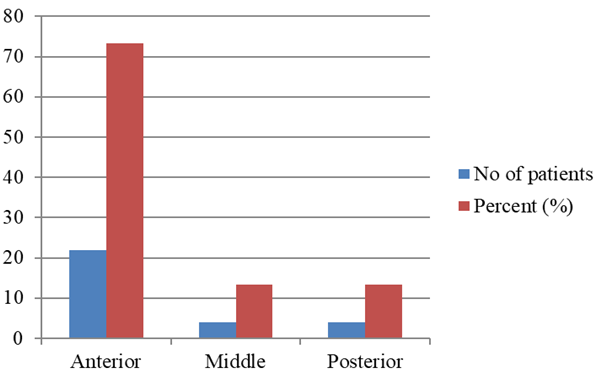Efficacy of the Posterior Urethral Incision Technique (PUIT) in Urethrocutaneous Fistula Repair Following Hypospadias Surgery
Abstract
Background: Urethrocutaneous fistula (UCF) is the most common complication following hypospadias repair, often requiring secondary surgical intervention. Despite advancements in surgical techniques, recurrence remains a significant challenge. The Posterior Urethral Incision Technique (PUIT) has been proposed as an alternative approach to improve UCF repair outcomes. This study evaluates the efficacy of PUIT in reducing UCF recurrence following hypospadias surgery. Methods: This prospective interventional study was conducted in the Pediatric Surgery Bangladesh Shishu Hospital & Institute, Dhaka, Bangladesh, from January 2017 to April 2018. A total of 30 patients aged 1–12 years with single UCF at least 6 months post-urethroplasty were included. PUIT was performed in all cases, and outcomes were assessed based on fistula closure rates and recurrence. Data were analyzed using SPSS version 26, with a significance level of p < 0.05. Results: The most common site of UCF was the coronal region (40%), followed by distal penile (33.3%), mid-penile (13.3%), and proximal penile (13.3%) sites. The overall success rate of PUIT was 83.3%, with 5 patients (16.7%) experiencing recurrence. Recurrence was highest in coronal fistulas (40%), with a statistically significant association between fistula location and recurrence (p < 0.001). Conclusion: PUIT is an effective technique for UCF repair, achieving a high success rate and low recurrence rate. It improves tissue approximation and reduces suture line tension, making it a reliable approach for fistula closure. Further studies with larger sample sizes and longer follow-up periods are recommended to validate its long-term efficacy.
Downloads
References
Duckett JW, editors. Adult and Pediatric Urology. 3rd ed. St. Louis: Mosby; 1996. p. 2541–88.
Murphy JP. Hypospadias. In: Ashcraft KW, Holcomb GW, Murphy JP, editors. Ashcraft’s Pediatric Surgery. 6th ed. Philadelphia: Elsevier; 2014. p. 783–94.
Shirazi M, Abdi H, Sharifiaghdas F, Beigi A, Armin A, Safarinejad MR. Urethrocutaneous fistula repair after hypospadias surgery: A new technique. Urol J. 2016;13(1):2502–6.
Mouriquand PDE. Hypospadias repair: A review. J Pediatr Urol. 2001;10(1):2–10.
Srivastava RK, Joshi P, Goyal P. Etiopathogenesis and management of urethrocutaneous fistula after hypospadias surgery: A review. J Pediatr Urol. 2011;7(5):512–8.
Elsaket A, El-Nashar A, Al-Kandari AM, Al-Saleh M, Shokeir AA. Urethrocutaneous fistula following hypospadias repair: Risk factors and surgical outcome. Ann Pediatr Surg. 2009;5(3):151–5
Jamal A, Eissa M, Fahmy M, Baky Fahmy A. Modifications to reduce fistula formation after hypospadias repair. J Pediatr Urol. 2010;6(5):506–10.
Goldstein AM, Hensle TW. Principles of hypospadias surgery. Urol Clin North Am. 1981;8(3):559–66.
Roberts JB. Rotation flap for fistula closure in hypospadias repair. J Urol. 1982;127(4):749–52.
Awad MM. Repair of urethrocutaneous fistula after hypospadias surgery: A novel technique. J Pediatr Surg. 2005;40(4):711–3.
Eardley I, Whitaker RH. Fistula repair following hypospadias surgery. Br J Urol. 1992;69(3):306–10.
Shankar KR, Losty PD, Hopper M, Wong L, Clarke RW, Thomas DF. Outcome of hypospadias fistula repair. BJU Int. 2002;89(1):103–5.
Ruchirendu S, Sharma P, Yadav SS. Midline posterior urethral incision technique in urethrocutaneous fistula repair: A new approach. Indian J Plast Surg. 2006;39(2):125–9.
Elbakry A. Management of urethrocutaneous fistula after hypospadias repair: A prospective study. J Pediatr Urol. 2001;6(3):125–9.
Muruganandham K, Shankar K, Gopalakrishnan G. Urethrocutaneous fistula after hypospadias repair: When, what, and how to manage? Indian J Urol. 2009;25(1):39–43.
Soni A, Sheoran S. Dartos-based flap repair for hypospadias fistula: A retrospective analysis. Urology Ann. 2007;3(2):65–9.
Hossein J, Ali M, Reza K. Buccal mucosa graft for the treatment of recurrent urethrocutaneous fistula. J Urol. 2009;182(6):2895–9.
Tolba AM, Ghoneim IA, Saad KM. Posterior urethral incision technique in urethrocutaneous fistula repair: A prospective study. J Pediatr Urol. 2009;5(3):185–90.
Mohamed A, Fathi K, Nabil S. Evaluation of posterior midline incision technique in hypospadias fistula repair. Egypt J Surg. 2010;29(4):245–50.
Aslam A, Ghaffar S, Haider A. Urethrocutaneous fistula following hypospadias repair: A retrospective study of risk factors. Ann Pediatr Surg. 2005;1(2):79–83.



























